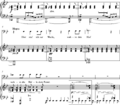Consonance and dissonance facts for kids
In music, consonance and dissonance are two words that describe how musical sounds, like intervals (two notes played together) or chords (three or more notes played together), make us feel. If a sound is consonant, it feels stable and pleasant. If it's dissonant, it feels unstable or even clashing.
What is Consonance?
A consonant sound is like a musical "home." It feels complete and peaceful. When you hear a consonant interval or chord, it often sounds pleasing to your ears. It's the kind of sound that can end a piece of music, making it feel finished. For example, playing the notes C and E together sounds nice and stable. The chord C, E, and G (which is a C major chord) also sounds very settled and pleasant.
What is Dissonance?
A dissonant sound is the opposite. It feels unstable and often creates a sense of tension. The notes might seem to "clash" a bit. Imagine a sound that makes you feel like it needs to go somewhere else. In traditional music, a dissonant sound usually doesn't end a piece. Instead, it "resolves" or moves to a consonant sound, which brings a feeling of relief. For instance, playing the notes C and F-sharp together creates a dissonant sound. It feels like it wants to move to a more stable combination.
The Science of Sound
Why do some sounds feel consonant and others dissonant? It has to do with how the notes vibrate. Every musical note has a specific vibration speed, called its frequency.
When two notes are consonant, their frequencies have a simple mathematical relationship. For example, if two notes are an octave apart, the higher note vibrates exactly twice as fast as the lower one. If they are a fifth apart, the top note vibrates 1.5 times faster. These simple relationships create smooth, blended sounds.
On the other hand, when notes are dissonant, their frequencies have more complex mathematical relationships. The more complicated the relationship, the more the notes might seem to clash, creating that unstable, tense feeling.
Images for kids
-
A sharply dissonant chord in Bach's Well-Tempered Clavier, vol. I (Preludio XXI)
See also
 In Spanish: Consonancia y disonancia para niños
In Spanish: Consonancia y disonancia para niños








